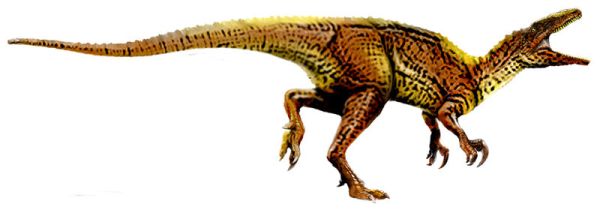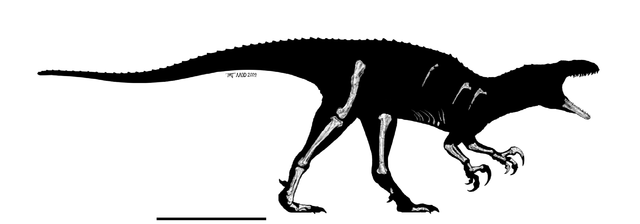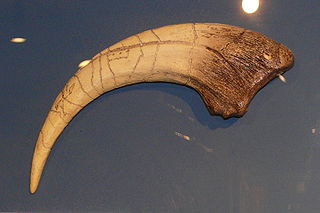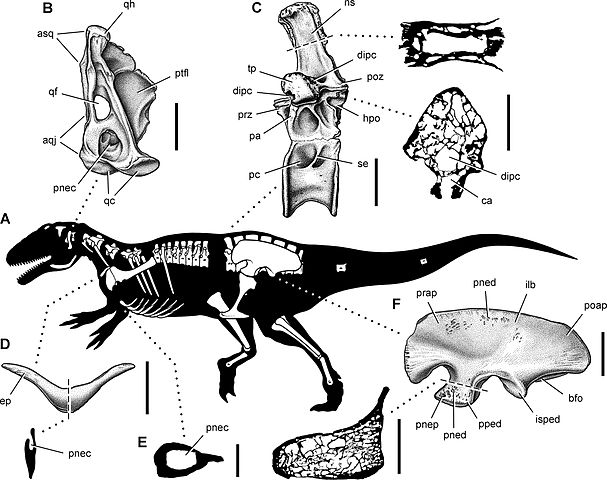Theropoda: Avetheropoda: Megaptora
Taxa on this Page
- Aerosteon X
- Australovenator X
- Chilantaisaurus X
- Fukuiraptor X
- Megaraptor X
- Megaptora X
- Orkoraptor X
- Siamotyrannus X

Australovenator wintonensis, Middle Cretaceous (Late Aptian), South-East Gondwana. Length 6 meters
Artwork by T. Tischler, Australian Age of Dinosaurs Museum of Natural History, from Hocknull et al 2009; Creative Commons Attribution; also on Wikipedia |
Despite the name, the megaraptors are not giant speilbergian scaly dinosaurs, but a newly recognised (Benson et al 2010) group of lightly built, long legged, fast running, highly specialised Cretaceous mostly gondwanan allosaurs with long grasping forelimbs, small to medium size, bird-like physiology, and other coelurosaur-like qualities. They averaged around 5 to 6 meters in length (Paul 2010) although the largest reached 9 to 10 meters. Although variously placed with Carcharodontosaurines (in the case of Megaraptor - Smith et al 2007), as a paraphyletic assemblage intermediate between allosaurids and carcharodontosaurids (Hocknull et al 2009) or as basal coelurosaurs (Mortimer - Theropod Database), we have followed Benson et al 2010, who provide the most complete study of the group, and retrieve the Megaptora as a monophyletic clade alongside the Carcharodontosaurids. It is not clear how megaraptors interacted with abelisaurs, although clearly there was some sort of niche partitioning that would allow the co-existence of two groups of large theropods over some tens of millions of years. MAK120304
Descriptions
Chilantaisaurus tashuikouensis Hu, 1964
Horizon: Ulanhushi Formation of the Dashigou Group, Nei Mongol, China (Aptian-Albian according to Mortimer, Turonian, making this species contemporary with Shaochilong maortuensis, according to Paul 2010
Phylogeny: Neovenatoridae : Neovenator + (Megaptora + *)
Size: length 11 meters. weight 2.5 to 4 tonnes
Comments: known from various postcrania, this giant theropod was originally placed in the Megalosauridae, then the Allosauridae-Tyrannosauridae spectrum (in the days when these were still both placed in a monophyletic Carnosauria, e.g. Paul 1988) and finally in the Neovenatoridae by Benson et al 2010. It therefore constitutes an independent lineage of giant mid Cretaceous theropods. A heavily built species, with well-developed arms and huge claws and hands (Paul 2010; Thescelosaurus) it appears to be an early off-shoot of the megaraptors that attained large size MAK120303
Megaraptora Benson et al 2010
Phylogenetic definition: The most inclusive clade comprising Megarator namunhuaiquii but not Chilantaisaurus tashuikouensis, Neovenator salerii, Carcharodontosauus. saharicus or Allosaurus fragilis (rank-free, stem-based). (Benson et al 2010).
Range: Barremian or Aptian to Maastrichtian of S Am, Aus, & E Asia
Phylogeny: Neovenatoridae : Neovenator + (Chilantaisaurus + * : Fukuiraptor + ?Siamotyrannus + (Australovenator + (Megaraptor + Aerosteon + Orkoraptor)))
Characters: long, gracile metatarsals (Benson et al 2010).
Comments: Unites a number of problematic taxa into a distinct but previously unrecognised clade; essentially, "crown group" (using the trem in a non-neontological context) neovenatorids. We have provided a very speculative phylogeny for this group, combining the dendrograms at Hocknull et al 2009, Mikko's phylogeny, and the Theropod Database MAK120304
Fukuiraptor kitadaniensis
Horizon: Kitadani Formation of the Akaiwa Subgroup of the Tetori Group, Japan (either Barremian or Albian)
Phylogeny: Megaptora : Siamotyrannus + (Australovenator + (Megaraptor + Aerosteon + Orkoraptor)) + *
Size: Length about 4.2 meters (Mortimer n.d.), weight 175 kg (Benson et al 2010)
Comments: Known from the partial remains of individuals from several growth stages, this species was originally considered a large dromaeasaur, its hand claw its hand claw mistaken for the maniraptoran foot claw. (Wikipedia) Similar to Australovenator in that both share a prominent posterolateral extension of the astragalus (Benson et al 2010), although Fukuiraptor might be a more basal form (Hocknull et al 2009). If the Barremian date is correct, this is the oldest known megaraptoran. MAK120304
Siamotyrannus isanensis Buffetaut, Suteethorn, and Tong, 1996
Horizon: Sao Khua Formation, Isan region of Thailand, (Early Cretaceous but not more precisely dated)
Phylogeny: Megaptora : Fukuiraptor + (Australovenator + (Megaraptor + Aerosteon + Orkoraptor)) + *
Size: length about 6.5 meters
Comments: Known from a fragmentary skeleton (partial hip, some vertebrae), this medium-sized theropod was originally described as the oldest known tyrannosaurid (Buffetaut et al., 1996), but is now considered a carnosaur of uncertain relationships, although Holtz et al 2004 placed Siamotyrannus with Fukuiraptor . Mickey Mortimer tentatively suggests allosaurid associations, although also noting some similarities to basal coelurosaurs, but resolves the taxon as intermediate between sinraptorids and Allosaurus. Because neither sinraptorids nor allosaurines are known from the Early Cretaceous, it would be unlikely that this taxon belongs there. We have placed it in the Megaraptora, pending new discoveries. MAK120304

Australovenator wintonensis Hocknull, White, Tischler, Cook, Calleja, Sloan, and Elliott, 2009
Horizon: Winton Formation, latest Albian, near Winton, central Queensland
Phylogeny: Megaptora : Fukuiraptor + Siamotyrannus + ((Megaraptor + Aerosteon + Orkoraptor) + *)
Size: length 4.8 meters (Mortimer, n.d.); or 6 meters and weight about 500 kg (Paul 2010)
Comments: a small to medium-sized allosauroid, known from teeth, dentry (lower jaw), and postcrania (Hocknull et al 2009).. The flat geography of Australia does not provide many geological outcrops, and so there are no impressive dinosaur skeletons such as have been found on other continents. The partially known Australovenator is therefore the most complete Australian theropod, and the only one known to date from more than a single bone. This animal was very similar to both Fukuiraptor and to "Allosaurus sp." known from an astragalus (ankle bone) from Victoria. it is also similar to NMVP186076, a Megaraptor-like form from the Early Cretaceous of Antarctica. Rapator ornitholestoides (known only from a single opalised bone), from the Aptian Griman Creek Formation of New South Wales, previously considered a coleurosaur, may also belong to this species or a very similar one. Phylogenetic analysis by Hocknull et al 2009 places Australovenator more basal than Neovenator, and Fukuiraptor more basal again, making the Megaptora a paraphyletic assemblage of Cretacous allosaurs. We have however followed the more complete anlaysis of Benson et al 2010 who retrieve the Megaptora as a monophyletic clade. MAK120304
Image: Australovenator wintonensis gen. et sp. nov. (QMF 7292), showing the material of the holotype. Artwork: T. Tischler, Australian Age of Dinosaurs Museum of Natural History. From Hocknull et al 2009; Creative Commons Attribution; also on Wikipedia

Megaraptor namunhuaiquii Novas, 1998
Horizon: Late Turonian/Early Coniacian of the Portezuelo Formation of Rio Neuquen Subgroup, Argentina
Phylogeny: Megaptora : Fukuiraptor + ?Siamotyrannus + (Australovenator + (Aerosteon + Orkoraptor + *))
Comments: Originally based on a single huge claw, about 30 cm long, that resembled a larger version of the "switchblade" giant toe claw of dromaeosaurs, Megaptor was at first considered an enormous dromaeasau. Later, the discovery of a complete forelimb, showed that the claw actually came from the first finger of the hand, and Megaptor was transferred to the spinosaurs. However the claws and hands are a different shape to that of spinosaurs (see also Wikipedia). Finally, Smith et al 2007 placed it with the Carcharodontosaurinae, while Benson et al 2010locate it in a new clade of carcharodontosaur cousins, the megarptora MAK120304
Image: Megaraptor namunhuaiquii, hand claw, photo by Haplochromis, Gno Free document license, Creative Commons Attribution-Share Alike, via Wikipedia

Summary of pneumatic features of the theropod Aerosteon riocoloradensis. (A)-Silhouette reconstruction in left lateral view showing preserved bones of the holotype and referred specimens (MCNA-PV-3137-3139); body length approximately 9-10 m. (B)-Left quadrate in posterior view. (C)-Dorsal 14 in left lateral view with enlarged cross-sections of the neural spine and transverse process. (D)-Furcula in anterior view with sagittal cross-section. (E)-Cross-section of medial gastral element from the anterior end of the cuirass showing pneumatocoel. (F)-Left ilium in lateral view with enlarged cross-section of pubic peduncle. Scale bars equal 5 cm in B, 10 cm (3 cm for cross-sections) in C, 10 cm (same for cross-section) in D, 2 cm in E, and 20 cm (6 cm for cross-section) in F. Abbreviations: aqj, articular surface for the quadratojugal; asq, articular surface for the squamosal; bfo, brevis fossa; ca, canal; dipc, diapophyseal canal; ep, epicleideum; hpo, hyposphene; ilb, iliac blade; isped, ischial peduncle; ns, neural spine; pa, parapophysis; pc, pleurocoel; pnec, pneumatocoel; pned, pneumatic depression; pnep, pneumatopore; poap, postacetabular process; poz, postzygapophysis; pped, pubic peduncle; prap, preacetabular process; prz, prezygapophysis; ptfl, pterygoid flange; qc, quadrate condyles; qf, quadrate foramen; qh, quadrate head; se, septum; tp, transverse process.. Caption and illustration from Sereno et al 2008, Creative Commons Attribution; also on Wikipedia |
Aerosteon riocoloradensis
Horizon: Anacleto Formation, Río Colorado, Mendoza, Argentina. (Late Santonian / Early Campanian)
Phylogeny: Megaptora : Fukuiraptor + ?Siamotyrannus + (Australovenator + (Megaraptor + Orkoraptor + *))
Size: 9 to 10 meters
Comments: probably similar to Megaraptor (Benson et al 2010), although somewhat later in time. At 9 to 10 meters in length, this was the largest known Megaptoran. The fossils are remarkable for the way they reveal a bird-like respiratory system; the bones contain air-filled spaces, including hollowing of the furcula and ilium, and pneumatisation of several gastralia (belly ribs), all of which suggests a respiratory air-sac system similar to that of modern birds. The air sacs would have acted like bellows, moving air into and out of the animal's relatively inflexible lungs, instead of the lungs being expanded and contracted as occurs with mammals. Hence Aerosteon - "air + bone" (Sereno et al 2008, via Wikipedia). All theropods would have had a similar physiology, but this is rarely preserved in fossil bones. MAK120304
Orkoraptor burkei Novas, Ezcurra, and Lecuona, 2008
Horizon: Pari Aike formation, Early Maastrichtian of southern Argentina (Paul 2010)
Phylogeny: Megaptora : Fukuiraptor + ?Siamotyrannus + (Australovenator + (Megaraptor + Aerosteon + *))
Size: 6 or 7 meters (Thescelosaurus)
Comments: Known only from fragmentary remains, this is the last known member of the Neovenatoridae, it shows that allosaurs continued to flourish until the very end of the Mesozoic. Its affinities with other Megaraptora are currently unclear Benson et al 2010; although Mickey Mortimer (Theropod Database) places it with Megaraptor and Aerosteon. if this interpretation is correct it would group all the Late Cretaceous west gondwanan megaraptors in a single clade,. MAK120304



